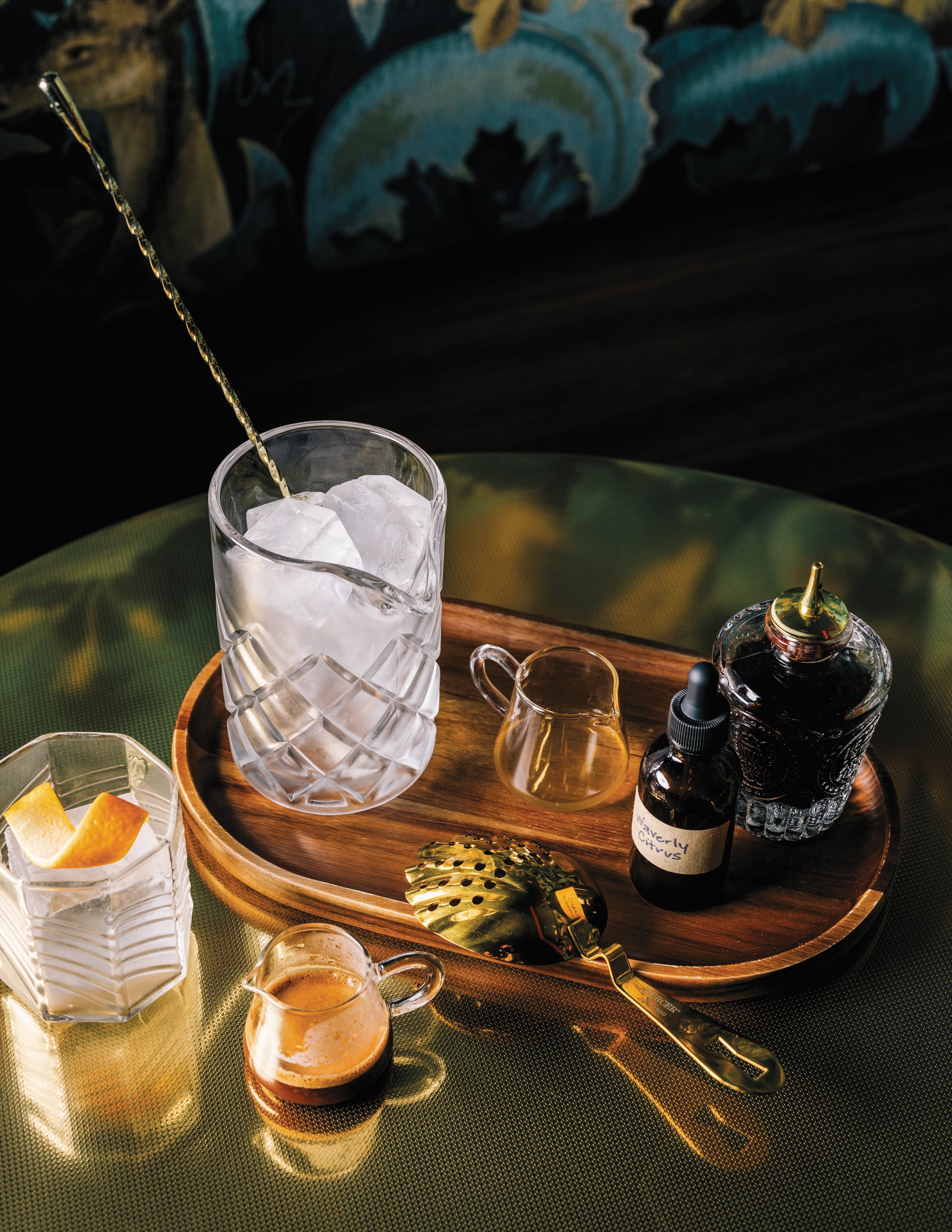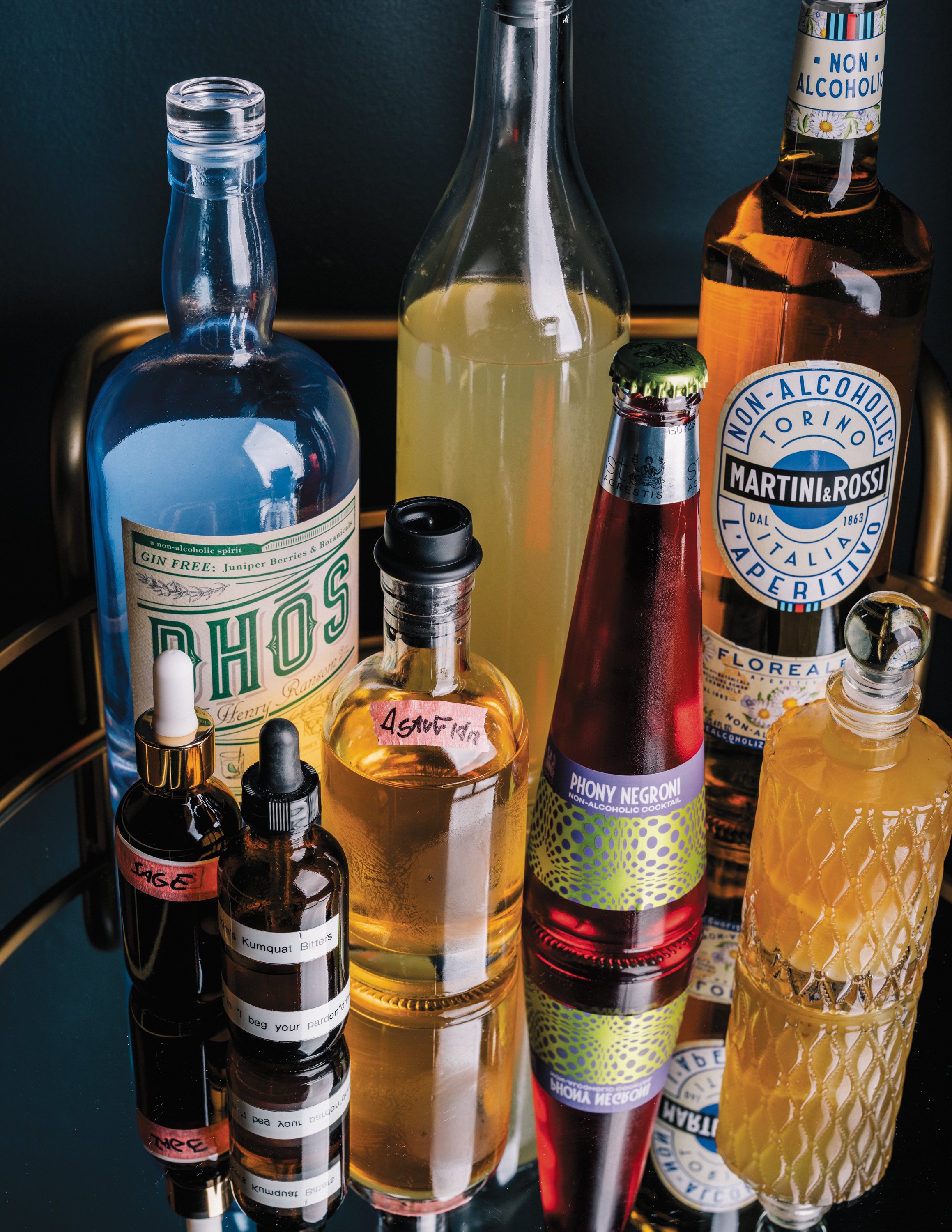Free Spirits: How to drink around Boston when you’re not drinking
Photos by Michael Piazza
A few days after my 40th birthday, I had my last drink of alcohol. There was no rock bottom. It was a well-mixed peach Old-Fashioned, made with fondly gifted bourbon, served in good company on a quiet night. But somehow I knew it would be my last; the days that followed turned to months, and that was it. Around the time you read this story, many more people will be thinking about trying out their own “Dry January.” Some of them will decide that they like how it goes, and will continue to see what exists in the space beyond alcohol.
In its earliest days, my choice felt laden with questions. Who was I if not a bacchanalian-inclined hostess? The absence of alcohol can feel so conspicuous it can create an echo. On menus, paltry alcohol-free cocktail options infantilized the choice. I ordered Shirley Temples. A local restaurant served me “mocktails” in children’s plastic sippy cups.
Caroline Knapp, a one-time Cambridge resident, wrote about the simple sensory pleasures of pouring out a drink in her memoir Drinking: A Love Story. “I loved the rituals, the camaraderie of drinking with others, the warming, melting feeling of ease and courage it gave me,” she writes.
I wondered if the ritual of a glass perpetually in hand for gatherings had short-changed my own social skills. After giving up alcohol, I showed up to the first party with $250 worth of bespoke mocktail fixings, and nervously tended what turned out to be a popular mocktail bar for the duration. More recently, I brought nothing to a party and sipped tap water out of a champagne glass all night. It was as if the salve to my own anxiety was masking the truth that I needed to carry neither the anxiety nor its cure.
In the months following my last drink, I considered the difference between turning toward something as opposed to turning away from it. Ordering with the term mocktail proved functional, usurping awkward preambles to my server. But still, it placed a linguistic emphasis on what something was not—and not what it was. I liked how I felt without alcohol. I wanted to like my drinks, too.
At Lynn’s Nightshade Noodle Bar, General Manager and Beverage Director Alexandra Caruso doesn’t use the word mocktail.
“[We’re] respecting that the folks who are ordering these don’t want a mock experience, and I’m not gonna give them that,” she says. Her program has evolved to keep step—including for zero-proof-opting diners—with the restaurant’s experimental tasting menu that can span as many as 14 courses.
“You’re not having a mock tasting menu when you get a gluten-free tasting menu. We’re trying to hold these drinks to the same level of respect, and the people consuming them with the same level of respect,” she says.
Since the pandemic began, Caruso has observed an increase in customers asking for alcohol-free options. But it’s a practical matter, too.
“If you were having … alcoholic beverages for every course, you probably wouldn’t be enjoying them toward the end,” she says. “You’re not tasting everything, your palate is exhausted, you’re getting really full.”
The classic cocktail movement hauled up speakeasy themes and archival recipes from the vault. But historically, mocktails were known as “temperance” cocktails, and if you drank them, you weren’t just a footnote, you were a killjoy. Trader Vic’s 1947 Bartender’s Guide chapter on the nonalcoholic lists mostly dolled up citrus-ades. “There comes a time when even your best customer goes off the wagon,” Vic writes, admitting they are passable at best. The Savoy Cocktail Book (1930) lists three, mostly juice and soda. The thinking that drinking is shorthand for fun is what I wanted to leave behind.
To build a great zero-proof cocktail today, Caruso said she applies the same standard as she would for any drink.
“Things that I’m craving in those moments are texture, bitterness, heat, presentation and complexity,” she says. But many programs approach the idea with a finite set of ingredients, resulting in boring sodas and legions of rehashed lemonades. In addition to herbal elements and syrups, Caruso has continued to explore new dimensions.
“I think what’s a little bit more interesting is finding ways to bring in savory notes, like with tannin, or milk-washing cocktails or other sorts of fat-washing to bring in texture,” she lists. “Spice, smoke.” Caruso waxed about creating flavor and texture from fatty plant proteins, and doctoring mouthfeel with soy lecithin and egg white. And though she stocks a few bottled spirit-free options, her priority has been to continue exploring the homemade.
“I’m finding other intriguing ways to get there,” she says, “and figuring out why something is satisfying, and not just trying to mimic it.”
In such a fast-paced, creative environment, Caruso described certain limitations that prevail: space, and a seafood-dominant menu, for instance. But creating comfortable hospitality for her alcohol-avoiding customers seems like one clear opportunity.
“It keeps me up at night when I see somebody at a bar seat … and then find out that they don’t drink and I worry that it was not a comfortable seat for them, you know?” she says. “I think it’s just part of what hospitality looks like these days.”
At Dorchester’s Comfort Kitchen, General Manager and Beverage Director Kyisha Davenport is telling stories guided by culture and community through her “free-spirited” menu, which as part of the full menu celebrates BIPOC producers and ethically sourced ingredients.
“I never really liked the word mocktail,” she says. “It just sounds harsh. Naturally, cocktails that are called mocktails don’t quite taste so great, either. I just think, ‘What if this is something a little more lighthearted? And just took the pressure off not wanting to drink as well. You know, it’s just a free-spirited thing.’”
Comfort Kitchen’s free-spirited menu includes the Baobab Express, made with baobab and Nepali white tea, one example of ingredients that Davenport said she sources to illustrate connections between the West African and South Asian diasporas.
“So that is literally going through the spice cabinet at home, to the spice rack here in the restaurant, to source ingredients that are really reflective of the places that we grew up in, or that we grew up away from,” she says.
Baobab is known as the “Tree of Life,” native to the African continent. “It’s this large, sprawling, beautiful behemoth of a thing,” she says. “And it has so much spiritual significance in the African community.”
Davenport created the cocktail after finding baobab powder in a local African market, which she matched with ginger, tea and orange blossom water. The resulting balance of acid, funk and earth is now one of the restaurant’s top-selling beverages. “It doesn’t feel like you’re just paying $10 for juice,” she says.
Davenport has also listed some unusual and noteworthy wine- or amaro-adjacent fermented libations, like the Danish-based Muri Passing Clouds and Nuala.
“I think oftentimes when we go out to restaurants, we think of the nonalcoholic beverages as being for children,” she says. “But it’s been really refreshing to see groups of grown people with the whole table full of food and drinks, and it doesn’t feel awkward to ask for them. It doesn’t feel like you’re being cheated out of an experience.”
The idea of “the third place” refers to a community gathering point outside the home: libraries, parks, churches and, of course, the bar. But after alcohol, that last option may no longer appeal. At Brookline’s BYOB Barlette, a bar with everything but the alcohol, it could be a way to return. Owner and bartender Rachel Trudel opened the bar thrilled by the creative potential of constraint.
“Everything we design is meant to be flexible,” she says. “And it’s meant to taste good on its own.” Guests are welcome to bring in their own zero-proof spirits— or, not. Trudel herself is not drinking alcohol at this time.
“Everyone who comes through our doors should feel like they’re in a place that sees them and where no one is an ‘other,’ right?” says Trudel. “There’s a lot of stigma around being a nondrinker. And when you come to Barlette, everyone’s treated the same… I think a lot of bars tend to accidentally create the sort of ‘other’ feeling, and we try really hard not to do that.”
It isn’t uncommon to order the one nonalcoholic beer on the menu and find it out of stock. But the list of those considering a more holistic version of hospitality is growing. It is good to find even a single menu offering, to raise the idea of nonalcoholic drinks—it is great to find a thoughtful list of its own. Other establishments working in the space include Blossom Bar, Hecate, Brassica and Backbar. Recognizing an expanding market and demand, Streetcar Wine and Beer owner Michael Dupuy said that in the past year, he has dramatically ramped up his in-store offerings. That includes Leitz de-alcoholized wines—which he said he can’t keep in stock—as well as Pathfinder nonalcoholic spirits, and Muri products, all a collection of some recent favorite tastings.
“I think they should be compelling in their own right, regardless of whether [the products are] alcoholic,” says Dupuy. And like anything he stocks, he says, “I think part of that, for me, is the origin story.”
Davenport revealed that she recently donated a kidney, and reduced her own intake. She said it’s important to continue the conversation around why some choose not to drink, or can’t, without making them feel isolated or ostracized. Restaurants take allergies seriously, she said, yet can fall short treating alcohol-free lifestyles the same.
“There’s this perception that you’re less of a person, you’re less exciting or less interesting without the alcohol,” she says. “Without the alcohol, who are you at the bar, how do you show up in a restaurant, you know? What do you need or don’t need in order to have a good time, so to speak. As a guest... you should have those options.”
drinkatbarlette.com
comfortkitchenbos.com
nightshadenoodlebar.com
streetcarwines.com




